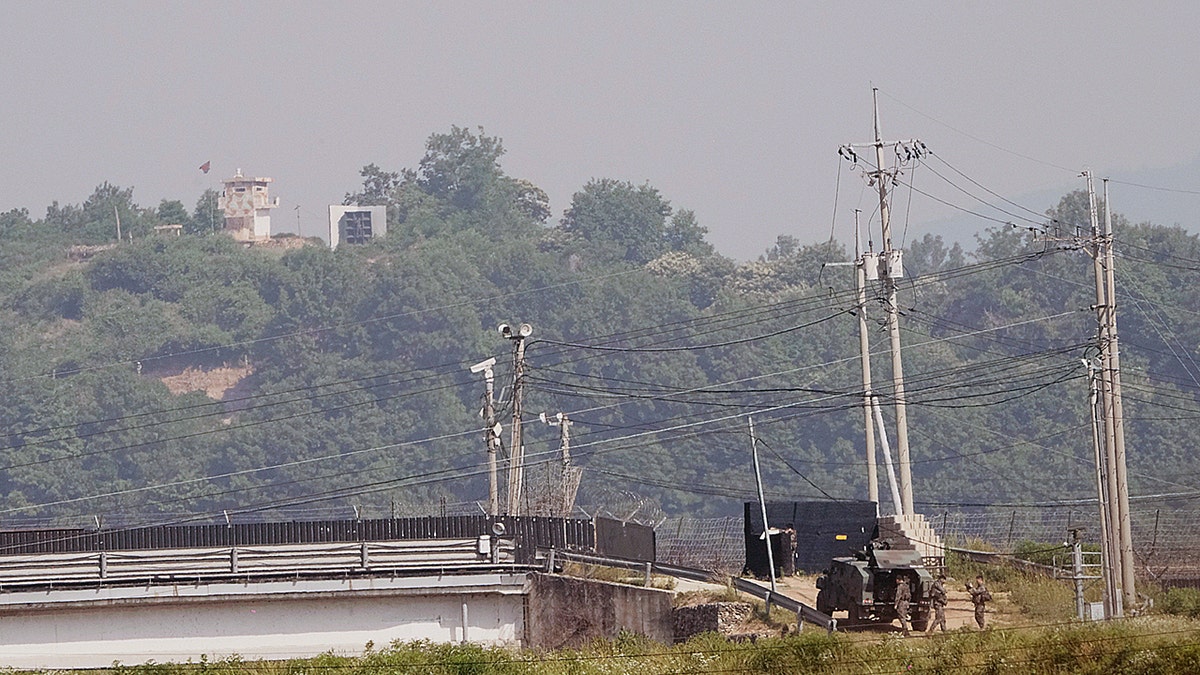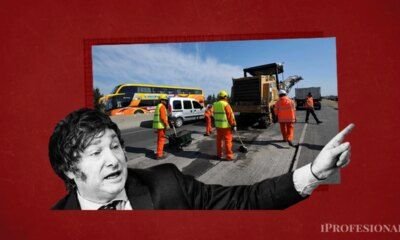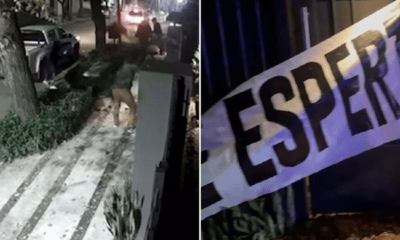INTERNACIONAL
North Korean avoids land mines to cross DMZ into South Korea as Seoul softens stance on Pyongyang

NEWYou can now listen to Fox News articles!
A North Korean man walked across one of the most dangerous borders in the world and into South Korean custody late Thursday.
The unidentified man, who was unarmed, crossed the heavily fortified Demilitarized Zone (DMZ), The Associated Press reported.
South Korea’s Joint Chiefs of Staff said troops tracked him near the central-west portion of the border and guided him through the mine-laced terrain before taking him into custody.
Military officials have not said whether the man was attempting to defect. The American-led United Nations Command was notified, and no unusual movement was observed on the North Korean side.
SOUTH KOREA FACES HIGH-STAKES ELECTION; FEARS OVER CHINA, NORTH KOREA AND US TIES SHAPE VOTER CONCERNS
A North Korean military guard post, left, and loudspeaker are seen from Paju, South Korea, near the border with North Korea, June 12. (AP Photo/Ahn Young-joon)
The crossing comes amid growing criticism of South Korea’s shift in strategy toward the North.
Since taking office June 11, South Korea’s liberal president, Lee Jae Myung, has taken steps to ease friction with Pyongyang. He halted loudspeaker broadcasts that blasted messages into the North and moved to ban balloon launches by activists carrying pro-democracy leaflets, according to The Associated Press.
Critics warn Seoul’s stance weakens deterrence and sends the wrong message to Kim Jong Un’s regime.
In recent weeks, there have been reports North Korea launched thousands of balloons filled with trash like cigarette butts and diapers into the South, the Wall Street Journal reported.
KIM JONG UN LEFT FUMING AFTER NORTH KOREA’S NEW DESTROYER DAMAGED IN FAILED LAUNCH

A North Korean military guard post, loudspeaker, top left, and South Korean army soldiers, bottom right, are seen from Paju, South Korea, near the border with North Korea, on June 12. (AP Photo/Ahn Young-joon)
Border incidents between the two Koreas are also becoming more frequent. In April, ten North Korean troops briefly crossed the military demarcation line before retreating after warning shots. Last year saw three similar incursions, according to The Associated Press.
Thursday’s incident involved not a group of soldiers, but a single man crossing from North Korea into the South. It is considered increasingly rare for possible defectors to choose this route; typical North Koreran defectors take a path through China instead.

Neighborhoods of North Korea’s Kaepoong village are seen from the observation post in Ganghwa, near the border with South Korea. (AP Photo/Ahn Young-joon)
Diplomatic talks between the U.S. and North Korea have been frozen since 2019, when denuclearization negotiations collapsed. Since then, Kim has poured resources into expanding his nuclear arsenal and repeatedly threatened both Seoul and Washington.
CLICK HERE TO GET THE FOX NEWS APP
President Donald Trump has warned North Korea that the U.S. will respond forcefully to any aggression. His administration remains committed to a strong alliance with South Korea and Japan, and to keeping a close watch on Pyongyang.
The Associated Press contributed to this report.
INTERNACIONAL
Why Trump’s undeniable winning streak is drawing a barrage of negative coverage

NEWYou can now listen to Fox News articles!
Donald Trump has just had the best few weeks of his presidency.
No question. No argument. Period, end of paragraph.
It began with a bold gamble to send pilots to destroy Iran’s nuclear sites.
Then Trump managed to broker a cease-fire between Israel and Iran.
TRUMP’S ACHIEVEMENTS EMBOLDEN HIM TO BE EVEN MORE AGGRESSIVE
Meanwhile, as Trump delayed his sky-high tariffs, the stock market hit record highs.
And he won a $16-million settlement from CBS’s parent company in his lawsuit against unfair editing by «60 Minutes.» That means he has now beaten two of the three broadcast networks, having won the same sum from ABC in a suit involving a crucial mistake by George Stephanopoulos.
And after days of pressure and arm-twisting, he managed to pass the Big Beautiful Bill.
President Trump’s been on a serious winning streak these past few weeks – culminating in the passage of his «big, beautiful bill.» (Samuel Corum/Getty Images)
Make no mistake, the bill was always going to pass. What were Republicans going to say, never mind, we just tanked the president’s main legislative priority because we didn’t like this or that?
They didn’t need Democratic votes, under so-called reconciliation. And Trump controls the GOP. So its members fell into line.
Now the question is why, through this successful stretch, has Trump continued to draw such negative coverage?
TRUMP SIGNS ‘BIG, BEAUTIFUL’ BILL IN SWEEPING VICTORY FOR SECOND TERM AGENDA, OVERCOMING DEMS AND GOP REBELS
For starters, many in the media just can’t stand the guy. And this has largely been true since 2015. So anything that helps him must be wrong and must be denigrated.
Even the successful strike on Iran drew only scattered instances of grudging praise, when under any other president there would have been standing ovations.
The press immediately reframed this as a debate over whether the bunker-busting bombs had only set back Iran’s nuclear program by a few months.

The press’ scant praise over Trump’s Iran strikes quickly devolved into debate over how far they really set back Tehran’s nuclear program. (Planet Labs PBC via AP)
In fairness, that’s what the preliminary, classified Intel report leaked to the press said. And there’s nothing wrong with reporting that accurately, even though the assessment was made with low confidence.
But Trump wants reporters for CNN and the New York Times, which broke the story, fired over this, and with an FBI leak probe under way, says he may force journalists to reveal their confidential sources.
Once the White House could no longer blame anonymous sources, there is nothing wrong with quoting a government report – even if if turns out to be wrong.
The cease-fire between Israel and Iran was fine, but that quickly morphed into chatter about why Trump couldn’t pull off an end to the fighting between Israel and Hamas, a far more difficult task.
AFTER SETBACK TO IRAN’S NUCLEAR PROGRAM, TRUMP EXPECTED TO LEVERAGE MILITARY SUPPORT IN NETANYAHU MEETING
Not to mention his freezing of weapons shipments to Ukraine, when despite his «very disappointing» call with Vladimir Putin, who promptly unleashed the biggest drone and missile attack against Kyiv since the illegal invasion of its sovereign neighbor.
Perhaps the president is learning what has been obvious to the rest of us: Putin has no conceivable interest in peace.
Everyone had to report the stock market surge, though not with the enthusiasm of the earlier plunge, and Trump yesterday announced that he’d hit Japan and South Korea, two allies, with a 25 percent hike in tariffs. But they don’t take effect till Aug. 1, so this could just be another negotiating tactic.

There was also next to zero coverage of Trump’s $16 million settlement with Paramount. (Yuki Iwamura/Bloomberg via Getty Images)
There was almost no television coverage of Trump’s $16 million settlement with Paramount, which is nothing more than the news business protecting its own. If this had been any other kind of company – with the backstory that someone like Shari Redstone needed administration approval to sell the company and pocket $2 billion – the press would have gone haywire.
Now there’s a new twist. Fox’s Charlie Gasparino, writing for the New York Post, reported the Paramount settlement includes a side deal between Trump and for the buyer David Ellison, son of tech mogul Larry Ellison, for him to run $15 to $20 million in advertising supporting causes backed by the president.
And Trump confirmed it.
«We did a deal for about $16 million plus $16 million, or maybe more than that in advertising,» he told reporters.
Paramount denied any knowledge of the side deal.
SUBSCRIBE TO HOWIE’S MEDIA BUZZMETER PODCAST, A RIFF ON THE DAY’S HOTTEST STORIES
The president has also been drawn into a war of words with Elon Musk, calling him a «train wreck» who’s gone «off the rails» in forming a third party and raising the Epstein files again. Musk says the lack of an Epstein client list is the «final straw» – he had once apologized for raising it – and there’s no difference between the Republican and Democratic parties.
But there was one moment, in my view, that was a misstep by Trump.
The president had no need to negotiate with Democrats, who strongly opposed a tax cut tilted toward the wealthy while making deep cuts to Medicaid.
«Every Democrat in Congress voted against the ‘Big, Beautiful Bill…They wouldn’t vote only because they hate Trump, but I hate them, too, you know? I really do. I hate them. I cannot stand them, because I really believe they hate our country.»
CLICK HERE TO GET THE FOX NEWS APP
I don’t believe the overwhelming majority of Democrats hate their country. And that was hardly a unifying message on July 4 weekend. Maybe many in the media hate him and he was just counterpunching. But he didn’t need to go there.
On the other hand, Donald Trump has been getting terrible coverage since 2015, and he’s clearly grown tired of it.
INTERNACIONAL
París: nadar en el Sena, un sueño que esperó más de 100 años y que solo duró un día

Cerradas hasta nuevo aviso
Burlas en las redes
INTERNACIONAL
Qué se sabe de las inundaciones que arrasaron Texas y dejaron más de 100 muertos, incluidos decenas de niños

Varias inundaciones catastróficas asolaron el centro de Texas durante el fin de semana festivo del 4 de julio y han causado la muerte de al menos 104 personas, entre ellas 28 niños. Hasta el lunes por la noche, 10 campistas y un consejero se encontraban entre los desaparecidos.
En el condado de Kerr, el río Guadalupe creció 6 metros en dos horas el viernes, lo que obligó la evacuación de varios campamentos de verano.
Cientos de equipos de rescate seguían buscando supervivientes el lunes, mientras gran parte del centro de Texas, incluida la región de Hill Country, estaba bajo alerta de inundación.
Esto es lo que sabemos sobre las inundaciones:
Hasta el lunes por la noche, al menos 104 personas habían muerto en el diluvio catastrófico. La mayoría, 84, estaban en el condado de Kerr, una parte de Texas Hill Country al noroeste de San Antonio.

Más de dos decenas de los fallecidos eran menores, entre ellos varias niñas de tan solo 8 años que habían estado en el Campamento Mystic, un lugar de verano a orillas del río Guadalupe con más de 750 asistentes. Dick Eastland, director durante muchos años del Campamento Mystic, también murió tras ser arrastrado, según reportes, mientras intentaba rescatar a las niñas de la crecida de las aguas.
Los funcionarios del condado de Kerr dijeron el lunes que aún no habían podido identificar a los 22 adultos y 10 niñas que aparecieron muertos tras las inundaciones.
Los equipos de emergencia han rescatado a más de 850 personas utilizando helicópteros, caballos, barcos y camiones. A un nadador de rescate de la Guardia Costera se le atribuye haber salvado a 165 personas del Campamento Mystic.

Pero al menos 10 niñas del campamento seguían desaparecidas el lunes por la noche, junto con más de una decena de personas en toda la zona.
Las autoridades dijeron que comenzarían los esfuerzos de recuperación, incluida la limpieza de escombros y la reapertura de carreteras. El domingo, el presidente Trump emitió una declaración de desastre mayor que dirige la ayuda federal a la zona.
En principio, Trump tiene previsto viajar a Texas el viernes, dijo el lunes Karoline Leavitt, secretaria de prensa de la Casa Blanca. La Casa Blanca estaba coordinando con las autoridades locales la visita de Trump para evitar perturbar los esfuerzos de recuperación, dijo Leavitt.
A primera hora de la tarde del jueves, el Servicio Meteorológico Nacional emitió una alerta de inundación general para el centro-sur de Texas, incluido el condado de Kerr. Cuando los ríos de la región empezaron a crecer el viernes por la mañana debido a las fuertes lluvias, el organismo aumentó el nivel de sus advertencias.

La alerta más urgente, enviada poco después de las 4 a. m., advertía de una “situación especialmente peligrosa” e instaba a los residentes y campistas a buscar terrenos más elevados. En unos 90 minutos, el río Guadalupe se había desbordado de un metro hasta 10 metros, según un indicador fluvial cerca de la ciudad de Comfort, Texas.
El aguacero continuó durante el fin de semana, mientras los equipos de respuesta de emergencia buscaban sobrevivientes.
Las inundaciones son una amenaza histórica en el centro de Texas, una zona a la que a menudo se denomina el “callejón de las inundaciones repentinas”, y la cuenca del río Guadalupe en particular es una de las regiones más peligrosas para este tipo de fenómeno. El cambio climático también ha intensificado y aumentado la frecuencia del tiempo extremo.

Entonces, ¿por qué el Servicio Meteorológico no envió antes su alerta urgente? Algunos expertos afirman que la escasez de personal de la agencia puede haber dificultado la capacidad de los meteorólogos para coordinar las respuestas con las oficinas locales de gestión de emergencias.
El senador Chuck Schumer, el principal demócrata del Senado estadounidense, pidió el lunes al inspector general en funciones del Departamento de Comercio que investigara si los recortes y la escasez de personal del Servicio Meteorológico habían contribuido al elevado número de víctimas mortales en Texas.
Por otra parte, los funcionarios del condado de Kerr contemplaron en su día la posibilidad de instalar un sistema de alerta de inundaciones a lo largo del río Guadalupe, pero finalmente rechazaron la idea por considerarla demasiado cara. Por eso, cuando la catastrófica crecida de las aguas se produjo el fin de semana, no hubo sirenas ni monitores de inundación temprana. Las alertas de texto llegaron tarde para algunos residentes y otros las desestimaron o no las vieron.

Aunque las autoridades no han hecho pública la lista completa de víctimas, algunas de ellas han sido identificadas por sus familiares.
Entre las víctimas se encuentran Jeff Wilson, profesor de secundaria de los suburbios de Houston desde hace muchos años, que estaba acampado cerca del río Guadalupe con su esposa; Tanya Burwick, de 62 años, que conducía hacia su trabajo en San Angelo cuando su vehículo quedó atrapado por la crecida de las aguas; y Blair y Brooke Harber, dos jóvenes hermanas que se alojaban en una cabaña junto al Guadalupe cuando la caseta fue arrastrada por las aguas.
© The New York Times 2025.
climate,damage,natural disaster,storm,texas,weather
-
POLITICA2 días ago
Para La Libertad Avanza el acuerdo con PRO está encaminado, pero aún hay mutua desconfianza
-
ECONOMIA10 horas ago
Chau Vialidad: anticipan una pelea por la financiación de 9.000 kilómetros de rutas
-
POLITICA3 días ago
🔴URGENTE – La Justicia liberó a tres militantes kirchneristas acusados en la causa por los desmanes en la casa de Espert























